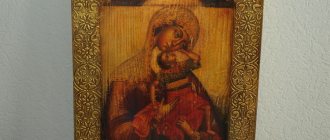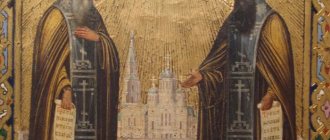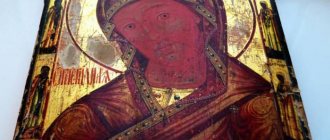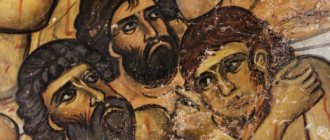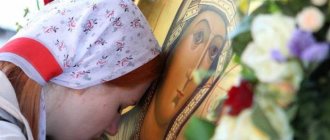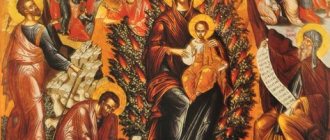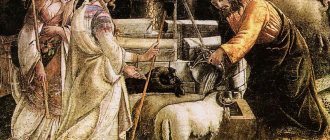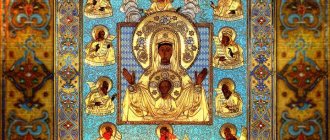Description of the icon of the Mother of God “Sweet Kiss”
The icon of “Glycophilus” is written in a manner related to the iconographic type “Tenderness” (“Eleousa”). Distinctive features of "Glycophilus":
- The Mother of God holds the Divine Child in her arms;
- The Virgin Mary tenderly kisses the Son, who pressed his cheek to hers;
- Jesus Christ hugs the Mother with one hand, and holds a scroll with the other;
- According to tradition, the Virgin Mary wears a red maforium decorated with three stars.
The sad look of the Most Holy Theotokos, foreseeing the fate of the Son, expresses immeasurable love and tenderness. By holding Jesus close to her, she seems to be trying to protect Him. But Christ has to save humanity by sacrificing his life. The original image has an image of the Crucifixion on the reverse side.
Icon “Kissing the Mother of God and Righteous Elizabeth”
Another name for this icon is “The Meeting of the Mother of God and the Holy Righteous Elizabeth.” (meeting means meeting). According to the Gospel tradition, after the Annunciation, or the appearance of the Archangel Gabriel, the Virgin Mary hurried to Elizabeth, her mother’s sister. Childless Elizabeth and her husband, the priest Zechariah, were already elderly people, but the Lord gave them a son, the future John the Baptist, with whom Elizabeth was pregnant at that time.
The ancient icon painter who painted the icon “The Meeting of Mary and Elizabeth” depicted these holy women with children in their wombs; the later icon "Kiss of the Virgin Mary" shows only their embrace. After meeting the Virgin Mary, Elizabeth was filled with the Holy Spirit and glorified Mary as the Mother of the Savior.
This icon is read for the protection of the Mother of God and for the birth of healthy and strong children.
The holiday is held on March 30/April 12.
History of appearance
The period of the reign of the second Byzantine emperor Theophilus, who ruled in the first half of the 9th century, was marked by a struggle with admirers of icons. Icon painters were required to renounce their craft. They were ordered to destroy their creations. Those who refused to submit to the heresy and remained faithful to the Church of Christ were subjected to torture. Monks were also imprisoned, and monasteries and monasteries were closed.
One of the emperor’s close associates, Simeon, especially zealously supported the iconoclastic views of his master. But his wife, Victoria, was a true Christian, adhered to Orthodox canons, and treated icons with respect. In her room she kept several holy images. But she treated the icon with the face of the Virgin Mary with special trepidation, to which she always turned during prayer.
The husband did not like his wife’s respectful attitude towards icons. One day he demanded that Victoria burn the holy image of the Mother of God. But a believing woman could not desecrate the shrine. For the sake of saving the holy image, she was ready to part with the icon. Victoria went to the sea, lowered the icon into the water, letting it float on the waves.
The Lord did not allow the holy image to perish. For many years the icon floated across the seas until it found itself near the shores of Holy Mount Athos. The shrine washed up on the coast of the Filofeevsky Monastery. The long voyage had no effect on the holy image; it remained unharmed.
The inhabitants of the monastery, led by the abbot, rejoiced at the appearance of the shrine, and installed it in the cathedral church. At the place where the image of the Mother of God was discovered, a healing spring began to flow. They called him "Agiasma". From the day of the appearance of the Mother of God, various miracles began to occur in the monastery.
One such incident occurred in 1801. The brethren of the monastery attached a golden holder to the frame of the “Sweet Kiss” icon. One of the pilgrims, seduced by the precious metal, stole the shrine. That same day he was planning to sail by ship, but the ship got stuck not far from the shore. Nobody could understand what happened. There was a fair wind, no problems were found on the ship, but no effort could be made to move the ship.
The abbot, having discovered the loss, organized a search for the shrine. One of the monks saw a ship standing not far from the shore. Without thinking twice, he took a boat to the ship. At the sight of the approaching monk, the thief was overcome by remorse, and he returned the stolen shrine. After this, the ship was able to continue on its way.
Among the many amazing cases that occur through prayers to the icon of “Glycophilus”:
- Cure of infertility for a couple from Pryor. After a prayer request to the Mother of God and anointing with oil from a lamp burning near the image, the couple were able to conceive and give birth to a healthy child.
- Delivering the brethren of the monastery from hunger during the war. When the monastery's storerooms were completely empty, a ship with grain moored to the pier. The monks were able to exchange the firewood the ship needed for further voyage for grain.
- The salvation of a pilgrim who doubted the power of a miraculous icon. The Bogomolets, falling from the top floor of the building, prayed to the Mother of God for help. Our Lady slowed his fall, and the man calmly sank to the ground.
This is only a small part of the miracles for which the icon became famous. The miraculous face to this day protects and protects Orthodox Christians who turn to the Most Pure Mother for help.
History of the holy image
During the reign of Emperor Theophilus, iconoclasm flourished. The emperor himself supported the ideas of abolishing the tradition of venerating icons, considering it a crime of the commandment against idolatry. Simeon, a servant close to the emperor, supported the views of his master. But Simeon’s wife was faithful to the canons and revered icons. This woman's name was Victoria. In her chambers she had many icons, but she especially revered the icon of the Mother of God, in front of which she always prayed.
Icon of the Mother of God “Sweet Kiss” (“Glycophilus”)
One day my husband demanded an icon in order to burn it. Victoria did not want to give such a shrine to desecration, which is why she threw the icon into the sea.
After some time, the icon miraculously appeared on the banks of Mount Athos, not far from the Philotheus Monastery. The abbot, together with the brethren of the monastery, placed the icon in the local church. The place where the icon appeared became revered. Now, according to tradition, every Bright Monday a religious procession is sent from the monastery.
Read about other icons:
- Icon of the Mother of God “Kursk-Root”
- Icon of Saint Princess Olga
- Icon of Mary of Egypt
Meaning in Orthodoxy
When you see the miraculous image, tears of happiness and tenderness appear in your eyes. The “Sweet Kiss” icon contains a deep theological idea. The contact of the faces of the Mother and the Son symbolizes the union of the heavenly and earthly, the Divine and the human.
Despite the fact that the icon depicts the communication of the Mother with the Son, the Mother of God does not distance herself from other people. The Heavenly Queen is ready to ask the Savior and Lord for all believers who turn to her for mercy and protection.
The holy face helps to cleanse the soul of all bad things, relieves fears and the severity of sin. When looking at the image of the Mother of God “Sweet Kiss”, confidence in the future comes.
Prayer to the Most Holy Theotokos before Her icon “Sweet Kiss” or “Glycophilus”
Accept, O All-merciful, Most Pure Lady, Lady Theotokos, these honorable gifts, the only ones applied to You, from us, Your unworthy servants, chosen from all generations, manifested above all creatures of heaven and earth. Because for Your sake the Lord of hosts was with us, and through You we knew the Son of God, and became worthy of His Holy Body and His Most Pure Blood. Blessed are you, too, in the birth of births, God-blessed One, the brightest of the Cherubim and the most honest of the Seraphim. And now, All-Singing Most Holy Theotokos, do not cease praying for us, Thy unworthy servants, that we may be delivered from every evil advice and from every situation, and that we may be preserved unharmed from every poisonous pretext of the devil. But even to the end, through Your prayers, keep us uncondemned, as if through Your intercession and help we are saved, we send glory, praise, thanksgiving and worship for everything in the Trinity to the One God and the Creator of all, now and ever and unto the ages of ages. Amen.
Reverence
The day of honoring the miraculous icon changes every year. The celebration of the shrine falls on Monday of Easter Week. This day is marked by a procession of the cross, as well as a prayer service.
The original icon can be seen by visiting the Philotheus Monastery, located on Holy Mount Athos.
But you can venerate the holy image of the Mother of God in other churches where the lists of “Glycophilus” are located. Two of them are kept in churches in the Moscow region - in the Dydyldinskaya Ilinskaya Church and the Church of the Nativity of the Blessed Virgin Mary in the Shchelkovo region. Like the original image, they have miraculous powers, healing terminally ill people.
Sweet Kiss
The icon of the “Sweet Kiss” (Glycophylussa in Greek) became famous during the reign of the Greek iconoclast Emperor Theophilus (829-842).
One of the emperor's close associates, Simeon, imitated his master in his hatred of icons. His wife Victoria secretly revered icons and had in her inner chambers an icon of the Mother of God, which she worshiped. The husband looked at this with indignation and finally demanded the icon from his wife in order to burn it. The believing woman decided to part with the treasured shrine, but not to deliver it into the hands of her husband.
She let her go into the sea.
After an unknown number of years, this very icon appeared on the seashore in front of the Athos Philotheus Monastery. The abbot and the brethren accepted her with joy and honor and brought her into the cathedral church of the monastery. The place where the icon appeared is called “Agiasma”. On Bright Monday, a procession of the cross takes place here from the monastery every year.
It is impossible not to mention here one edifying miraculous incident that happened in 1830. At this time, one pilgrim came to the Philotheevsky Monastery from Adrianople. Here in the monastery he accidentally spoke with the ecclesiarch. The latter, in a sincere conversation, told the pilgrim about various miracles of the Mother of God and also reported how Her icon of the Sweet Kiss appeared on the seashore in front of the Athonite Philotheus monastery.
Bogomolets curiously asked the ecclesiarch about everything, listened carefully to his stories and, apparently, took everything to heart. The Ecclesiarch complied with his wishes. But what was his amazement when his interlocutor finally expressed his doubts about the truth of everything told, and considered the monk’s story about the miraculous appearance of the icon of the Mother of God Glykofilussa to be a simple fable that only a child could believe.
The Ecclesiarch thought for a moment. He didn't expect anything like this. There is no doubt that evil seeds were sown in the soul of the pilgrim, and they poisoned his Christian mood. Perhaps he was already close to a complete collapse. After all, from denying the benefits shown to the human race by the Mother of God, and from doubting the miraculous appearance of Her holy image, there is only one step to doubting miracles in general, and in particular, the miracles of the Savior of the human race.
Seeing the imminent death of his interlocutor, the ecclesiarch tried to dispel his spirit of doubt, but the pilgrim stubbornly denied all his words and arguments. He fell so deep.
And it was not the monk’s arguments that convinced the pilgrim: he was returned to the number of sincere followers of Christ by the Queen of Heaven Herself.
On the same day, a miracle happened to him, and from it he could be convinced of the miraculous power of the Most Pure Virgin. Walking along the top floor of the house, he tripped and began to fall down. Then he exclaimed: “Most Holy Mother of God, help us!” and descended to the ground without any harm.
The Sweet Kiss icon is also glorified by other miracles. It stands in the cathedral church of the monastery and depicts the Mother of God kissing the Eternal Child. The icon is 1 arshin 12 vershoks in height, and 1 arshin 3 1/2 vershoks in width. There is a church tradition that it is one of the 70 icons painted by the Evangelist Luke.
In the monastery of the Russian Athonite Panteleimon Monastery there is a photograph from the miraculous icon “Glycophylus”.
What does the “Sweet Kiss” icon help with?
According to the legends of the Philotheus monastery, the miraculous icon helps to cope with many troubles and misfortunes.
Turning to “Glycophilus”, believers ask:
- grant good health;
- relieve torment;
- strengthen in faith;
- forgive sinful thoughts and deeds;
- heal from physical and mental illnesses;
- protect from the machinations of ill-wishers.
“Sweet Kiss” provides special patronage to childless couples who pray for the gift of healthy, strong offspring. Through prayers to the image of the Mother of God, parents manage to return children who have strayed from the true path to a righteous life.
In front of the Mother of God icon, you can tell about everything that worries you. The Blessed Virgin Mary will definitely hear and help you cope with difficulties.
For the soul...(What helps you live)
In the cathedral of the Athonite monastery of Philotheus, on the left choir there is the famous miraculous icon of the Mother of God “Sweet Kiss” (Greek: “Glycofilus”). According to legend, it was written by the Evangelist Luke.
www.pravoslavie.ru/sas/image/101879/187974.p.jpg?mtime=1412800752
During the reign of the Byzantine iconoclast emperor Theophilus (829-842), the pious resident of Constantinople Victoria, the wife of one of the emperor's close associates named Simeon, saving the icon from destruction, at the risk of her life, honored and kept it in her room. Her husband demanded that she burn the icon, but Victoria preferred to throw it into the sea. So the image arrived on the Holy Mountain, about which Abbot Philotheus was miraculously warned. At the place where the icon was found, holy water flowed out.
From then until now, on Easter Monday, a procession of the cross has been carried out from the monastery to the site of the appearance of the icon.
www.pravoslavie.ru/sas/image/101879/187975.p.jpg?mtime=1412800819 Place of appearance of the “Sweet Kiss” icon
In 1793, Deacon Ioaniky, while lighting candles in front of the icon, often complained that the Mother of God does not care about the monastery, because the other monasteries of Athos do not need anything, but Philotheus does.
One day the deacon made his complaint at midnight. He was very immersed in his prayer and did not notice anything around him. Suddenly the Mother of God appeared before him in a mysterious light and said that his complaints and lamentations were in vain - if it were not for her care, the monastery could not exist. He asks for wealth in vain - gold and silver are of no use to the monastery.
When the deacon woke up, he realized that he was mistaken and humbly asked for forgiveness from the Most Pure One. Then he told the brethren about what he had seen.
In 1801, a money-loving pilgrim stole the gold coins hanging from the image. Having committed sacrilege, he boarded a ship departing from the Iverskaya pier. But the ship, having sailed a little from the shore, stood still, despite the tailwind. Meanwhile, when they learned about the loss in Filothea, they sent people in all directions to catch up with the thief. One of them sailed on a boat to the ship, which was stationed not far from the Iverskaya pier. Meanwhile, the criminal, enlightened by the miraculous stop of the ship, himself repented of the sacrilege and hastened to voluntarily return the gold coins, after which the ship freely continued sailing.
www.pravoslavie.ru/sas/image/101879/187976.p.jpg?mtime=1412800874
It is impossible not to mention here one edifying miraculous incident that happened in 1830. At this time, one pilgrim came to the Philotheevsky Monastery from Adrianople. Here in the monastery he accidentally spoke with the ecclesiarch (the caretaker of the temple). The latter, in a sincere conversation, told the pilgrim about various miracles of the Mother of God and also reported how Her icon of the Sweet Kiss appeared on the seashore in front of the Athonite Philotheus monastery.
Bogomolets curiously asked the ecclesiarch about everything, listened carefully to his stories and, apparently, took everything to heart. The Ecclesiarch complied with his wishes. But what was his amazement when his interlocutor finally expressed his doubts about the truth of everything told, and considered the monk’s story about the miraculous appearance of the icon of the Mother of God Glykofilussa to be a simple fable that only a child could believe.
The Ecclesiarch thought for a moment. He didn't expect anything like this. There is no doubt that evil seeds were sown in the soul of the pilgrim, and they poisoned his Christian mood. Perhaps he was already close to a complete collapse. After all, from denying the benefits shown to the human race by the Mother of God, and from doubting the miraculous appearance of Her holy image, there is only one step to doubting miracles in general, and in particular, the miracles of the Savior of the human race...
Seeing the imminent death of his interlocutor, the ecclesiarch tried to dispel his spirit of doubt, but the pilgrim stubbornly denied all his words and arguments. He fell so deep.
And it was not the monk’s arguments that convinced the pilgrim: he was returned to the number of sincere followers of Christ by the Queen of Heaven Herself.
On the same day, a miracle happened to him, and from it he could be convinced of the miraculous power of the Most Pure Virgin. Walking along the top floor of the house, he tripped and began to fall down. Then he exclaimed: “Most Holy Mother of God, help us!” and descended to earth without any harm...
www.pravoslavie.ru/sas/image/101879/187977.p.jpg?mtime=1412800924
Another miracle in the list of countless miracles revealed by the icon happened to one Christian from Pryor. His wife could not have children, and therefore the couple suffered greatly. While on Mount Athos, the Holy Mountain, the Christian fervently prayed to the Blessed Virgin before the “Sweet Kiss” icon. Before going home, he took some oil from the lamp burning in front of the icon and, returning, anointed himself and his wife with it. And in the same year his wife gave birth to a son. The Christian was very grateful to the Virgin Mary and brought a gift to the monastery of Philotheus.
www.pravoslavie.ru/sas/image/101879/187978.p.jpg?mtime=1412800976 Procession with the “Sweet Kiss” icon
Through prayers at the icon of the Mother of God, many miracles have happened in our time. One of them occurred during the years of German occupation. A story about him is contained in the book of Elder Paisius of Svyatogorsk, “Fathers of Svyatogorsk and Svyatogorsk Stories: During the German occupation, the supplies of wheat in the monastery of St. Philotheus were running out, and the fathers decided to stop receiving visitors. One pious elder, Father Savva, having learned about this, was saddened and began to beg the council of the elders of the monastery not to do this, because by doing this they would sadden Christ and the monastery would lose its blessing. He cited many examples from the Holy Scriptures, including the story of the widow of Zarephath of Sidon and the prophet Elijah (see 1 Kings 17), and they finally listened to him. However, after some time, they began to pester the elder with reproaches, saying: “The torment is over.” What will happen now? The elder answered them: “My fathers, the little that is left will be eaten together with the people, and the Mother of God will not leave us.” There were only twenty-five okadas of wheat left in the monastery’s storerooms and nothing else, and the monks began to rather sarcastically reprimand Father Savva: “Father Savva, the wheat is over, what will happen now?” But the pious and faith-filled elder answered this: “Do not lose hope in Glykofilusa.” Knead the remaining twenty-five okadas, bake bread from them and distribute it to the brethren and laity, and God, as the Good Father, will take care of us all. When they ran out of last bread, they didn’t even have time to get hungry when a ship coming from Kavala moored at the monastery pier, and the captain offered to exchange the wheat he was carrying for firewood. The monks, seeing the obvious Providence of the Mother of God, Who, like a Good Mother, took care of Her children, glorified God. Of course, Father Savva glorified God and thanked the Mother of God most of all, always sending thanks to Her with his very holy life. After this, he reminded the fathers: “Didn’t I tell you that the Mother of God will not leave us?”
www.pravoslavie.ru/sas/image/101879/187979.p.jpg?mtime=1412801031
Before the icon of the Most Holy Theotokos “Sweet Kiss”, or “Glycophylussa” they pray for strengthening in the Orthodox faith, for the protection of Orthodox icons, in times of troubles and adversity, in case of physical and mental ailments.
Prayer to the Most Holy Theotokos before Her icon “Sweet Kiss”, or “Glycophilus”
Accept, O All-merciful, Most Pure Lady, Lady Theotokos, these honorable gifts, the only ones applied to You, from us, Your unworthy servants, chosen from all generations, manifested above all creatures of heaven and earth. Because for Your sake the Lord of hosts was with us, and through You we knew the Son of God, and became worthy of His Holy Body and His Most Pure Blood. Blessed are you, too, in the birth of births, God-blessed One, the brightest of the Cherubim and the most honest of the Seraphim. And now, All-Singing Most Holy Theotokos, do not cease praying for us, Thy unworthy servants, that we may be delivered from every evil advice and from every situation, and that we may be preserved unharmed from every poisonous pretext of the devil. But even to the end, through Your prayers, keep us uncondemned, as if through Your intercession and help we are saved, we send glory, praise, thanksgiving and worship for everything in the Trinity to the One God and the Creator of all, now and ever and unto the ages of ages. Amen.
Troparion, tone 7
The overpowering heresy, about Thy most honorable icon, O Virgin, dost thou manifestly provide for: the journey of Thy monastery, as a gift worthy of offering. With this we rightly call the Sweet-loving One, we please Thee.
Kontakion, tone 8
To those who come to Thy temple and monastery and who persecute God in a saving manner and honor Thy holy image, grant, O Virgin, Thy mercy, from all these sorrows, who cry out to Thee: Rejoice, O One Unblessed of God.
Greatness
We magnify You, Most Holy Virgin, God-chosen Youth, and honor Your holy image, through which you bring healing to all who come with faith.
Sources: Kondakov N.P. Iconography of the Mother of God. Complete Orthodox Theological Encyclopedic Dictionary. T.II. St. Petersburg: P.P. Soikin Publishing House. P.2077. Elder Paisiy Svyatogorets. Svyatogorsk Fathers and Svyatogorsk Stories E. Poselyanin. Our Lady. Description of Her earthly life and miraculous icons" [1914] agioritikesmnimes.blogspot.ru/2012/03/982.html Χαραλάμπους Δ. Βασιλόπουλου, “Θαύματα της Παναγίας”
agionoros.ru/docs/1403.html
www.isihazm.ru/?id=487
Orthodox texts
In order for the prayers of believers turning to the Most Pure Virgin in front of the “Sweet Kiss” icon to be more effective, prayer texts were written. Before asking the Most Holy Theotokos for help, they read a special prayer or one of the short hymns of praise - a troparion or kontakion.
Troparion
Of the overpowering heresy, about Thy most honorable icon, /Virgo, thou manifestly provide: / for the journey of Thy monastery, / as a gift worthy of offering. / We rightly condemn this sweetly kissing one. // We'll please you.
Kontakion
Whosoever in Thy temple and monastery / cometh Thee and persecutes salvation in a godly manner / and venerates Thy holy image / hereby grant. Virgin, Thy mercy, / delivered from all these sorrows, / crying unto Thee: // Rejoice, O One Unbrided of God.
Where to hang
According to church tradition, icons are placed on the wall facing east. At home, sometimes this is not possible. Most often, images are hung (or placed) in the right corner, opposite the door to the room. Any holy face, including the icon of the Mother of God “Sweet Kiss” can be located in any living room - living room, bedroom, nursery. The main thing is that the image has free access and can be seen from all sides. Nothing should distract the thoughts and attention of a believer during prayer. You should not place bright objects nearby that will interfere. These are bright posters, paintings, souvenirs and other trinkets.
The only decoration of the icon can be a beautiful icon case and embroidered towels. It is important to provide a place in front of the image for a burning candle or lamp. In this case, it is necessary to take care of fire safety and not leave an open fire unattended.
- Modern list of the “Sweet Kiss” icon.
Icon of the Mother of God "Sweet Kiss" ("Glycophilus")
Celebration:
Story
The icon of the “Sweet Kiss” (Glycophilus in Greek) became famous during the reign of the Greek iconoclast emperor Theophilus (829–842).
One of the emperor's close associates, Simeon, imitated his master in his hatred of icons. His wife Victoria secretly revered icons and had in her inner chambers an icon of the Mother of God, which she worshiped. The husband looked at this with indignation and finally demanded the icon from his wife in order to burn it. The believing woman decided to part with the treasured shrine, but not to deliver it into the hands of her husband.
She let her go into the sea.
After an unknown number of years, this very icon appeared on the seashore in front of the Athos Philotheus Monastery. The abbot and the brethren accepted her with joy and honor and brought her into the cathedral church of the monastery. The place where the icon appeared is called “Agiasma”. On Bright Monday, a procession of the cross takes place here from the monastery every year.
It is impossible not to mention here one edifying miraculous incident that happened in 1830. At this time, one pilgrim came to the Philotheevsky Monastery from Adrianople. Here in the monastery he accidentally spoke with the ecclesiarch. The latter, in a sincere conversation, told the pilgrim about various miracles of the Mother of God and also reported how Her icon of the Sweet Kiss appeared on the seashore in front of the Athonite Philotheus monastery.
Bogomolets asked the ecclesiarch with curiosity about everything, listened carefully to his stories and, apparently, took everything to heart. The Ecclesiarch complied with his wishes. But what was his amazement when his interlocutor finally expressed his doubts about the truth of everything told, and considered the monk’s story about the miraculous appearance of the icon of the Mother of God Glykofilussa to be a simple fable that only a child could believe.
The Ecclesiarch thought for a moment. He didn't expect anything like this. There is no doubt that evil seeds were sown in the soul of the pilgrim, and they poisoned his Christian mood. Perhaps he was already close to a complete collapse. After all, from denying the benefits shown to the human race by the Mother of God, and from doubting the miraculous appearance of Her holy image, there is only one step to doubting miracles in general, and in particular, the miracles of the Savior of the human race.
Seeing the imminent death of his interlocutor, the ecclesiarch tried to dispel his spirit of doubt, but the pilgrim stubbornly denied all his words and arguments. He fell so deep.
And it was not the monk’s arguments that convinced the pilgrim: he was returned to the number of sincere followers of Christ by the Queen of Heaven Herself.
On the same day, a miracle happened to him, and from it he could be convinced of the miraculous power of the Most Pure Virgin. Walking along the top floor of the house, he tripped and began to fall down. Then he exclaimed: “Most Holy Mother of God, help us!” and descended to the ground without any harm.
The Sweet Kiss icon is also glorified by other miracles. It stands in the cathedral church of the monastery and depicts the Mother of God kissing the Eternal Child. The icon is 1 arshin 12 vershoks in height, and 1 arshin 3 1/2 vershoks in width. There is a church tradition that it is one of the 70 icons painted by the Evangelist Luke.
In the monastery of the Russian Athonite Panteleimon Monastery there is a photograph from the miraculous icon of “Glycophilus”.
Prayers
Troparion to the Most Holy Theotokos before the Icon of Her “Sweet Kiss”
The possessing heresy, / about your honorable icon, O Virgin, / you clearly provide: / the journey of your abode / as a gift worthy of offering. / And here we denounce the sweet-loving right, / / You have lost we're waiting.
Translation: Because of the heresy that has taken hold (of the Empire), You clearly have a providence for Your reverently revered icon, O Virgin: on a sea voyage to Your monastery You bring (the icon) as a worthy gift. We rightfully call this icon “Sweet Kiss” and glorify You.
Kontakion to the Most Holy Theotokos before Her Icon “Sweet Kiss”
Whoever comes to Thy temple and monastery, and persecutes God for salvation, and venerates Thy holy image, hereby grant, O Virgin, Thy mercy, and deliver Thee from all these sorrows. those who live: Rejoice, O One Bride of God.
Translation: Grant, O Virgin, Thy mercies to all who come to Thy temples and monasteries, make godly offerings and venerate Thy holy image, and deliver from all sorrows those who cry to You: Rejoice, O Only One who is ignorant of God.
